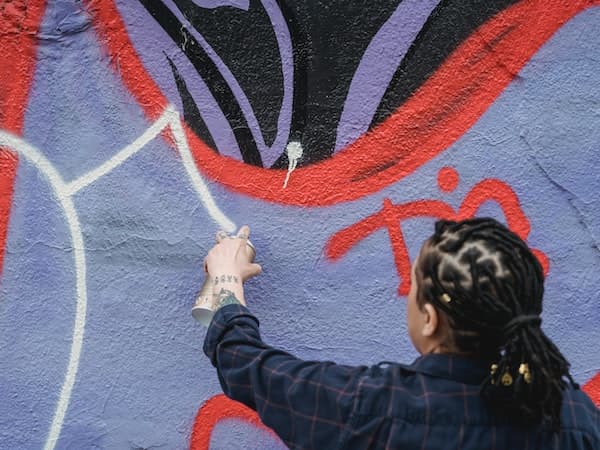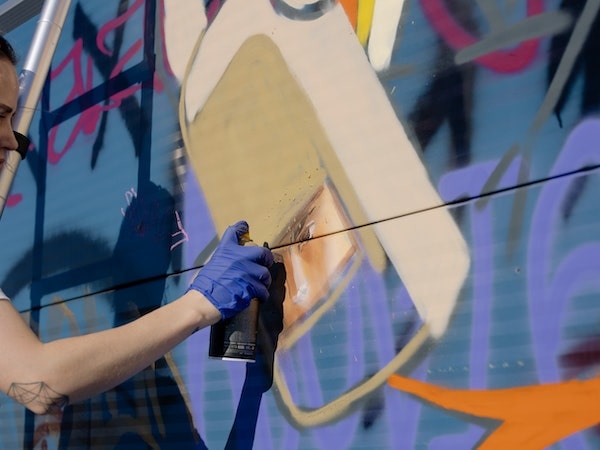When starting a spray painting project, every painter’s goal is to create a clean, smooth finish.
Whether you’re an amateur or seasoned painter, no one wants to end up with dripping paintwork.
This is sometimes difficult to achieve, especially with slicker metal or plastics. One reason your project is likely to fail is painting on a dirty surface.
All that dirt, dust, grease, and rust will not make the paint adhere to the substrate. The same happens if you spray without shaking the can properly or holding it in the right position and distance.
So if you’re wondering how to spray paint without drips, these are the main factors to consider.
But to help you understand why your paintwork isn’t turning out as beautifully as you’d expect, read this guide, and you’ll know how to spray paint without drips.
How to Spray Paint Without Drips.
Start by shaking the can thoroughly. Then learn how to control the can: not too close or far off. Always maintain consistency when spraying: move the can steadily back and forth and apply light coats. Above all, the surface should be clean, smooth, and well-primed to improve adhesion.
How to spray paint without drips: Step by Steps
Spray painting without drips calls for a meticulous approach devoid of mistakes. If you need to become an expert, you should refer to a tried and proven guideline to inform the steps which you should follow to the latter.
Below we’ve outlined the steps we use in our spray painting projects for a smooth surface.
No matter which material or substrate you’ll be working on, these steps will give you that beautiful finish you thought you couldn’t achieve.
Step 1: Mix Spray Paint
You should ensure the surface you want to spray on is spotlessly clean without any dirt or dust. Surface cleaning and preparation is crucial, so start with that.
Then once done, mix your paint thoroughly by shaking and unclogging the can (in case it’s clogged with old paint). Ensuring the paint is well mixed up to the right texture is the first step to avoiding drips.
This is because it’s common for paint to settle during shipping or handling, and shaking it thoroughly helps mix and atomize it properly for a good and uneven spray.
Step 2: Don’t Start Spraying On The Project Directly
Now the surface and paint are ready. You feel tempted to begin spraying right away on the object. Except there are better ways to start your project.

First, you want to test whether the paint is even and if the nozzle works correctly. You also want to determine if you can control the can from a solid angle.
That’s when it becomes necessary to spray test on a piece of paper or cardboard. You can adjust or replace the nozzle and shake the can once more if the results are unsatisfactory.
From there, you can begin painting the object itself.
Start by spraying away from the center of your artwork, moving smoothly from the object’s edges in a straight line across the object while applying constant pressure until you get to the center.
Step 3: Cleaning and Wiping of Nozzle
Drips usually occur and are highly noticeable during the early stages of spray painting. As you move from the edges to the center of the object, you will likely notice some dripping from the nozzle.
It could be a case of paint build-up or nozzle malfunctioning. Fix this problem by cleaning the nozzle or replacing it with a more efficient paint sprayer gun.
Ensure you keep a dry piece of cloth nearby by which you can wipe the paint on the nozzle from time to time.
Sanding the surface
One downside about spray paints is that sometimes you may encounter too many unexplained drips. The dripping may persist no matter which precautions you’ve set in place.
In this case, don’t attempt to fix every drop, as this will show or mess up your work. Instead, finish spray painting and let the paint dry out completely, then lightly sand the surface to smoothen the bumps.
A fine-grit sanding block should do the job perfectly. Lightly apply thin coats on the sanded area and see what could have been a disaster transform into a beautiful art piece.
Sanding is especially important on rough surfaces like concrete and bricks as they tend to get horribly pitted in case of drips.
Use Spray Trigger
Spray triggers are particularly important if you plan to do a lot of painting. Spraying in itself can be tiresome, and if you plan to cover a large surface area, you’ll get worn out and get finger fatigue from holding that little button consistently.
Consider investing in a spray trigger to make your spray painting work more efficiently and less messy.
Avoid Spraying Closely
Another way to prevent paint drips when spraying painting is to maintain some distance from the object they’re covering. Most paint sprayers and cans have labels indicating the space should be 10-12 inches away.
Too close, and your work will be heavy and runny. Too far away, and most of it will dissolve in the air, causing a lot of wastage, not forgetting that what lands on the object will start to harden, creating a rough surface.
With a 10-12 inches distance from the object, you will manage to apply light, even coats.
Let the Surface Dry Before Another Coat
Waiting for the surface to dry after the first coat before applying a second coat is important and highly recommended. This is important because continuous spray painting creates heavy paints on the object.
Not only will you prevent drips and runs on your design, but you’ll also achieve a smooth, clear finish that doesn’t get smeared by touch.
Ensure Proper Temperatures
Any professional spray painter will tell you that spray painting outdoors is more recommended since it aids in faster drying of paint. However, this is only possible if the weather is warmer and less windy. You can check out my dedicated article on how to make spray paint dry faster for more insights on spray paint drying.
So, try as much to avoid working in cold, rainy, or windy weather. Also, to ensure thin paint and thin layers, the temperature should not exceed 50-90 degrees Fahrenheit.
And when working indoors, maintain proper air circulation to safeguard yourself against fumes and for the paint to dry faster.
How to Fix Spray Paint Drips?
Sometimes mistakes happen, and no matter how careful you are, you might encounter a drip here and there.
When that happens, you want to correct the problem without ruining your design. So how do you fix paint drips quickly and meticulously? Here are a few ways to do it:
Wait for the paint to dry completely, then sand with fine grit sand block until it’s the same level as the rest of the surface, then repaint it, taking care to avoid drips this time.
Work with a spray can that has a fan nozzle to enable you gently mist over the drip, blending the entire surface.
Use a plastic scraper or putty knife to gently scrape off excess paint from minor drips.
Consider fixing spray paint drips when wet, which is much easier than when the paint is dry. Otherwise, follow the above steps on how to spray paint without drips.
Why Am I Getting Lines When I Spray Paint?
If you encounter lines while spray painting, it could be due to several reasons, chief of them being.
Clogging: A clogged nozzle is a likely cause of lines and uneven marks on your painted surface. You can correct this by cleaning the nozzle with a paperclip to improve the paint flow.
Thickness: If the paint is too thick, the result will be thick lines of too much paint and other imperfections. Fortunately, this can be solved with a paint thinner or paint conditioner. Add a small thinning to the paint and shake the can well to mix it up.
Wrong distance: Hold the spray can within the recommended distance and angle according to the label: not too far and not too close to enable you to spray more evenly.
Finally, always work on a clean, spotless surface for best results and to eliminate lines.
Tips to Get a Smooth Finish on Spray Paint?
Here are some additional tips to achieve a smoother finish on your spray painted products:
Apply a light touch and multiple thin coats to help minimize the number of drips and overspray for a beautiful finish.
Consider light sanding the surface between layers using fine-grit sandpaper. This helps eliminate minor imperfections creating a smooth surface on which to apply the next coat.
Spray at a distance consistent with your speed and movement, ensuring maximum coverage.
After applying the final coat, let it dry, then use very fine-grit sandpaper (320-400) to sand it gently.
As a final touch, buff it with a foam sanding pad to remove any slight visible imperfections. Always remember that creating a smooth finish requires patience, practice, and extra effort.
If you can do that by following this guide, drips and blotchiness will be the least of your worries.
FAQs: How to Spray Paint Without Drips
What makes spray paint drip?
Several factors contribute to painting drips. It could be a lack of proper surface preparation, thick paint, wrong distance and angle from the object, inconsistency in spraying, and a clogged nozzle. You should identify and rectify these problems before spray painting.
How do you spray paint without wasting it?
Avoid making long, continuous sprays if you want to get the most out of each spray paint can. Instead, keep them as short as possible to prevent your paint from drying faster.
The faster the paint dries, the more you’ll need to ensure maximum coverage, and this can be wasteful, so maintain short bursts of spray.
How do you spray paint like a professional?
For a professional finish, applying thin, even layers is vital. Work with a spray can with a wider opening to allow even paint distribution.
Consider using a sprayer if the can has a narrow nozzle. The wider the opening, the better and more professional your work will be.
How do you fix paint runs?
Use a drop cloth to prevent any paint runs and excess paint from getting on the floor or ground. A container can suffice in place of a drop cloth.
You should also wear painting clothes or overalls and gloves to avoid paint splatter on your clothes.
Conclusion on How to Spray Paint Without Drips
Spray paint is affordable and efficient, making it the most popular method of sprucing up old household items or transforming cheap craigslist finds.
And because it’s versatile, you can use spray paint on anything made of various materials, from rubber to wood to metal and even glass.
Yet quite often, what would seem like a simple spray paint project can quickly flop if not properly done.
Drips, crackling, and uneven coverage are all common setbacks you’re likely to encounter when spraying paint. Still, they can be easily avoided if you take the time to do everything right.
So we created this guide to help you avoid drips and similar problems next time you want to undertake a new spray painting project. We hope you find this guide helpful.

